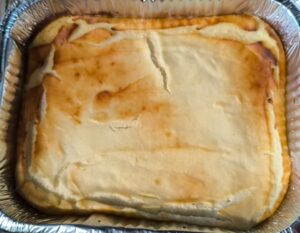 I think most kids like soda and other fizzy drinks. Mine do, at least, but we’re an “as unprocessed as possible” home, not to mention pretty frugal home, so soda is something I don’t generally buy. For the past while, kombucha has been our replacement soda. But the thing is, in order to make kombucha, you have to have access either to a kombucha mother or some ready kombucha with which to grow your own kombucha mother. What if you don’t have a source for kombucha making equipment? Can you still make lacto-fermented drinks and get also the taste benefit, and also the health benefits?
I think most kids like soda and other fizzy drinks. Mine do, at least, but we’re an “as unprocessed as possible” home, not to mention pretty frugal home, so soda is something I don’t generally buy. For the past while, kombucha has been our replacement soda. But the thing is, in order to make kombucha, you have to have access either to a kombucha mother or some ready kombucha with which to grow your own kombucha mother. What if you don’t have a source for kombucha making equipment? Can you still make lacto-fermented drinks and get also the taste benefit, and also the health benefits?By making lacto-fermented soda.
Lacto-fermented soda is made by adding a probiotic culture to juice or any other sweetened drink, and letting it ferment. This transforms the drink into a fizzy, sweet and sour, nutritionally beneficial drink that tastes good.
You can make lacto-fermented soda with whey strained from homemade kefir or homemade yogurt (just stick them in a cheesecloth, and use the liquid that drips out), but we’re a dairy free home, so dairy based lacto-fermented sodas don’t work here.
Fortunately, you can make your own vegan probiotic starter culture- a ginger bug- with just 2 easy to get ingredients.
How to Make a Ginger Bug
First, I have to give credit to this post on A Life Unprocessed, as that’s where I learned how to make a ginger bug as well as lacto-fermented soda.
“The proliferation of lactobacilli … produce numerous helpful enzymes as well as antibiotic and anticarcinogenic substances. Their main by-product, lactic acid… promotes the growth of healthy flora throughout the intestine.”
Sally Fallon, Nourishing Traditions, pg 89
From Dr. David Williams’ newsletter Alternatives:
“Traditional fermented foods help balance the production of stomach acid. Fermented foods have the unique ability to.. [and] ease digestive discomfort related to having either too much or too little stomach acid.
Fermented foods help the body produce acetylcholine, […] a neurotransmitter [which] increase the movement of the bowel, can alleviate constipation problems, […] acts as potent digestive aids.
Traditional fermented foods are beneficial for people with diabetes[-] improving pancreatic function, […] carbohydrates in lactic acid–fermented foods have been broken down or “pre-digested,” […] and don’t burden the pancreas.Fermented foods produce numerous unknown compounds that destroy and inhibit the growth of pathogenic bacteria, such as cholera and typhoid… lactic acid bacteria found in sourdough bread, and discovered that it seemed to be more effective than other strains at killing microbes […] quickly eliminated the super-bugs currently resistant to most antibiotics.
Health Benefits of Ginger
- Ovarian Cancer Treatment as per study at the University of Michigan Comprehensive Cancer Center.
- Colon Cancer Prevention as per a study at the University of Minnesota.
- Morning Sickness as per several studies that concluded that ginger is just as effective as vitamin B6 in the treatment of morning sickness.
- Motion Sickness Remedy.
- Reduces Pain and Inflammation-ginger has anti-inflammatory properties and is a powerful natural painkiller.
- Heartburn Relief when taken in the form of tea.
- Cold and Flu Prevention and Treatment.
- Helpful for stomach flus or food poisoning, positive effects ginger has upon digestive tract.
- Migraine Relief- it stop prostaglandins from causing pain and inflammation in blood vessels.
- Menstrual Cramp Relief
- Prevention of Diabetic Nephropathy
Are you a soda drinker? What is your favorite type of soda? Do your kids like it? Have you ever heard of lacto-fermented soda before? Have you heard of a ginger bug before? Have you ever made either? If so, what flavor did you like to make?
Does this seem like something you’d try?
Do you try to have probiotics regularly, either in pill form or via fermented foods and drinks? What do you take to give you probiotics?







0 Responses
I know this is an old post – I make mine with various juices and teas. I make it every summer. It's easier than water Kefir. I just compost it at the end of autumn, and start another the following spring.
We have milk Kefir and Viili all year round.
What is "Viili" never heard of it?
Viili is an almost strictly Finnish fermented dairy product =) The closest English translation I've ever come across is "clabbered milk" . Used to be that the only way to start a viili culture was to add some viili to milk, my mother in Canada specifically requested some ecological viili (as in not processed to death) when we visited from Finland, but I don't know if she got it to work with the pasteurised stuff sold in stores… I'll refer her to this post and see if she can pull it off.. Personally I can't ingest anything made with cow's milk – with the notable exception of cheese and chocolate – without my sinuses going crazy from MCAS, but I might try it with oat milk sometime =) I found an oat-based Greek yogurt that was a bit sweet to my palate so I'm always open to novel ideas =)
Meri
I don't like whey OR ginger! I am going to try creating my starter with apple juice, dandelion leaf, dandelion root powder, a bit of my sourdough bread starter plus some lacto bacteria probiotic powder. God willing.